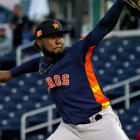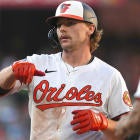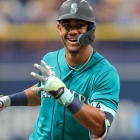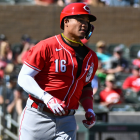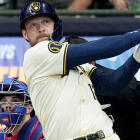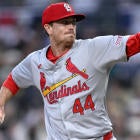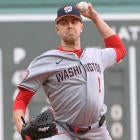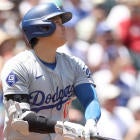Perhaps I'm alone in this, but it just so happens that all of my Dynasty Fantasy leagues are 24 teams deep. That's a lot of teams, and since the dynasty format is one that emphasizes prospects, it means digging deeper into the prospect pool than just a top 100 list.
Which is fine, because there's nothing magical about a top 100 list. It's the norm in the prospecting world because it makes for a nice round number, but it's an arbitrary cutoff, especially for a process that relies heavily on judgment calls. By how many degrees of certitude does No. 80 stand out from No. 140? I think most prospect evaluators would admit it's virtually none.
Many of the high-end players you know in Fantasy baseball today were among the highest rated throughout their minor-league journey, but many were not. Did you know Paul Goldschmidt was never on a preseason top 100 list -- at least not ones as well known as Baseball America, MLB.com and Baseball Prospectus? It's true. What about Jose Ramirez, Jose Altuve and J.D. Martinez? Nope, nope and nuh-uh. And pitchers? Shoot, we'll just stick to the Indians organization. Not a one of Shane Bieber, Mike Clevinger and Corey Kluber were.
Clearly, then, there are chances to hit big beyond the big names, so that's one tack you could take: targeting less-celebrated types with interesting stats and skills. Or you could also try to corner the next big name by targeting recent international signings who are too young to have made their presence known yet. It's a riskier approach that'll require some patience on your part, but if you're green with envy over someone else's Wander Franco or Julio Rodriguez, well, you may need to go out on that limb every once in a while.
What follows are some of the prospects I find myself gravitating toward once the usual suspects are gone.
Michael Busch, 2B, Dodgers
A: 3 for 24, 7 BB, 5 K
AFL: 3 for 13, HR, SB, 9 BB, 4 K
Scouts are divided over whether Busch can stay at second, but not over whether he'll hit. The 22-year-old should make quick work of the minors with the sort of on-base skills that would have filled entire chapters in Moneyball.
Kody Hoese, 3B, Dodgers
Rookie/A: . 299 BA (147 AB), 5 HR, .863 OPS, 18 BB, 25 K
Another disciplined hitter, Hoese's power is a little more developed than that of Busch, already playing up to all fields. And as with Busch, the Dodgers' reputation for getting the most out their prospects makes it easier to invest in someone so untested.
Jordan Balazovic, SP, Twins
A/A+: 8-5, 2.69 ERA, 0.98 WHIP, 93.2 IP, 25 BB, 129 K
With a big fastball, whifftastic slider and projectable frame, Balazovic made easy work of A-ball and is just a changeup away from having a front-line pitcher projection.
Joe Ryan, SP, Rays
A/A+/AA: 9-4, 1.96 ERA, 0.84 WHIP, 123.2, 27 BB, 183 K
Scouts have long underestimated the pitcher who hides the ball well in his delivery, which is largely responsible for Ryan's seemingly average fastball becoming such a difficult pitch to hit (along with his willingness to locate it up in the zone). His secondary arsenal needs work, but he had the lowest WHIP, the second-most strikeouts and the third-best ERA among minor-leaguers despite pitching against fairly advanced competition.
Aaron Bracho, 2B, Indians
Rookie/A-: .281 BA (135 AB), 8 HR, 4 SB, .973 OPS, 28 BB, 29 K
Bracho's smallish size may limit his power ceiling, but his bat control and strike-zone judgment give him an offensive profile that stands out among second basemen, far away though he may be. Could he be a Michael Brantley-type hitter?
George Kirby, SP, Mariners
A-: 8-2, 2.75 ERA, 0.89 WHIP, 88.1 IP, 6 BB, 107 K
Though he went later in the first round, Kirby looks like one of the most projectable pitchers from the 2019 draft class. He's still working on a changeup but already has a good feel for two different breaking balls, which, combined with his plus-plus control, makes for a pretty nifty Shane Bieber comp.
Cristian Javier, SP, Astros
A+/AA/AAA: 8-3, 1.74 ERA, 0.97 WHIP, 113.2, 59 BB, 170 K
Sometimes it's as easy as identifying the bonkers stat line and trusting that something is being overlooked therein. For Javier, it may be a matter of how effective he is at varying the speed on his fastball, which disrupted hitters' timing to the tune of a .130 batting average against.
Braden Shewmake, SS, Braves
A-/AA: .300 BA (247 AB), 3 HR, 18 2B, 13 SB, .796 OPS, 25 BB, 40 K
Some evaluators thought the Braves reached for Shewmake with their second pick of the first round last year, noting that he doesn't have much of power profile, but what that assessment sells short is just how easy it is to cultivate power in today's game. Shewmake's 6-foot-4 frame gives him a leg up in that regard, and he's thought to be on the fast track as a versatile bat-first type.
Brett Baty, 3B, Mets
Rookie/A-: .234 BA (188 AB), 7 HR, 16 2B, .821 OPS, 35 BB, 65 K
Power is the defining tool for Baty, who went 12th overall in last year's draft but nonetheless isn't getting much love in Fantasy circles because of his 20 years of age and lackluster showing in the lower minors. But he isn't just some pure masher like Nolan Gorman, also showing an ability to work the count and hit the ball the other way.
Kris Bubic, SP, Royals
A/A+: 11-5, 2.23 ERA, 0.97 WHIP, 149.1 IP, 42 BB, 185 K
Though the last of the four pitchers the Royals selected in the first round of the 2018 draft, Bubic put up the most impressive stat line of the bunch last year. He struggles to maintain the sort of velocity that's expected of a big-time hurler these days, which no doubt hurts his prospect standing, but his changeup is so good that it may not matter.
Seth Corry, SP, Giants
A: 9-3, 1.76 ERA, 1.07 WHIP, 122.2 IP, 58 BB, 172 K
Remember how I said it's sometimes as simple as picking out the bonkers stat line? The knock on Corry is that he supposedly can't throw strikes, but his walk rate dropped from 6.7 BB/9 over his first 14 starts to 2.4 over his final 13. His curveball is a hammer with big swing-and-miss potential.
Alejandro Kirk, C, Blue Jays
A/A+: .290 BA (310 AB), 7 HR, 31 2B, .868 OPS, 56 BB, 39 K
Kirk got some attention early in spring training because he doesn't look like the typical baseball player, being short and rotund. But what may have been overshadowed in that conversation, brief as it was, is the quality of his bat, which earned him a 70-grade hit tool from Baseball America. The 21-year-old has walked more than he has struck out at every level so far and has a reasonably good chance of sticking behind the plate.
Braxton Garrett, SP, Marlins
A+/AA: 6-7 3.54 ERA, 1.28 WHIP, 106.2 IP, 40 BB, 119 K
Garrett is like Max Fried all over again. Both were drafted seventh overall but saw their stock take an immediate hit because of Tommy John surgery, which tends to ding a pitcher's prospect ranking more than it should. Both throw left-handed. Both have ground-ball arsenals highlighted by high-end curveballs that allow them to miss their share of bats as well.
Heriberto Hernandez, OF, Rangers
Rookie/A-: .345 BA (200 AB), 11 HR, 17 2B, 1.071 OPS, 29 BB, 60 K
Whenever a scouting report describes a prospect's best position as "the batter's box," which Baseball America does for Hernandez, it should be music to a Fantasy player's ears. The bat is all that matters for our purposes, provided it's good enough to earn him a job somewhere on the diamond, and yet that defensive uncertainty is sometimes enough to bury a guy in the rankings even when he shows serious offensive upside.
Playing the long game
These recent international signings have scarcely played in the minors, but the scouting reports suggest they have the upside to rocket up the rankings.
Noelvi Marte, SS, Mariners
Marte, 18, has already seen a little action in the minors, having signed in 2018, and has drawn comparisons to Hanley Ramirez.
Maximo Acosta, SS, Rangers
Gleyber Torres is the totally-unfair-but-nonetheless-instructive comparison that scouts make for the 17-year-old Acosta, who offers an advanced hit tool, projectable power and enough athleticism to stick at shortstop.
Luis Rodriguez, OF, Dodgers
The Dodgers' reputation for developing players makes an investment in the 17-year-old Rodriguez especially worthwhile. He's already a disciplined hitter with an all-fields approach who most scouts are confident will grow into power.
Luisangel Acuna, SS, Rangers
Ronald Acuna's younger brother earns bonus points for those bloodlines, though it's not so clear he's going to be a true power threat. He's smaller, yes, but already has a penchant for making hard contact.
Arol Vera, SS, Angels
A switch hitter with good baseball instincts, Vera shows a strong command of the strike zone and the sort of bat speed that should develop into power in time. He earns high marks for defense, too.
Bayron Lora, OF, Rangers
Even at 17, Lora has earned a 70 power grade from Baseball America, and MLB.com suggests he has Joey Gallo potential at the plate. It means he's also defined by his whiffs, which could derail him before he ever reaches the bigs.









